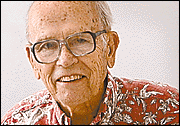


Hawaii’s World
THE late Wallace Fujiyama, when he was a University of Hawaii regent, used to count cars in the Manoa campus faculty parking areas. Not enough there in the afternoons, he griped to me more than once. How hard does
UH faculty work?Gov. Ben Cayetano recently called the attention of the Star-Bulletin editorial board to a 1997 report by the state auditor that seems to point toward the same thing -- with numbers.
It says UH teaching loads in 1994-95 were so light that close to 50 percent more courses might have been offered system-wide within accepted national standards for teaching loads of 12 classroom hours per week.
Among the 10 campuses there was considerable variation. By the more liberal of two methods of counting used for the audit, Manoa scored only 8.1 classroom hours average per faculty member but Leeward and Windward Community Colleges went above the standard of 12 to 13.11 and 12.52 respectively.
On April 7, 1997, a lengthy response to the audit was made jointly by the UH regents and UH president. It was published as a part of the audit and about equaled it in length. One statement was that faculty by then had already minimized the effect of recent budget cuts on students by carrying heavier teaching loads.
A more enduring response -- made then and still espoused by top university leaders with whom I touched base -- is that a land grant university like UH has three missions: teaching, research and community service.
Manoa is the campus where most research is based. Researchers are allowed much lower teaching loads.
Colleen O. Sathre, vice president for planning and policy, said surveys show a remarkable convergence on 50 hours as an average work week for college faculty across the nation. She thinks it applies at UH, too.
Former UH President Fujio Matsuda answered me with a question: "Does everyone at the Star-Bulletin work as hard and effectively as everyone else?" He is satisfied that UH faculty members overall do their jobs quite well.
The regents' chairman, Donald C.W. Kim, thinks so, too.
What do good faculty members do when they aren't in the classroom? Research is a very big component, particularly at Manoa. Faculty members win research grants equaling roughly one-third of what the state appropriates to UH. National fame and leadership have been won by biogenesis and astronomy.
BEYOND research there is community service. It is quite real and takes many forms. Hawaii would be much poorer without some of the contributions made by UH faculty in tackling tough community problems.
Class lecture preparation and student counseling are other significant elements in a faculty work week. Credit goes, too, for time spent on administration -- which presumably includes a charge to see that work load responsibilities are fulfilled, department by department.
For a university thirsty for dollars, the 1997 auditor's report seemed to spot an undertapped well of resources already bought and paid for.
I trust the auditor and also trust the university leaders I touched base with. I come away from my inquiries with the sense the problem is not as severe as the 1994-95 numbers make it seem, but would be tickled to see a new audit requested for 1999-2000.
http://www.kaleo.org
A.A. Smyser is the contributing editor
and former editor of the the Star-Bulletin
His column runs Tuesday and Thursday.